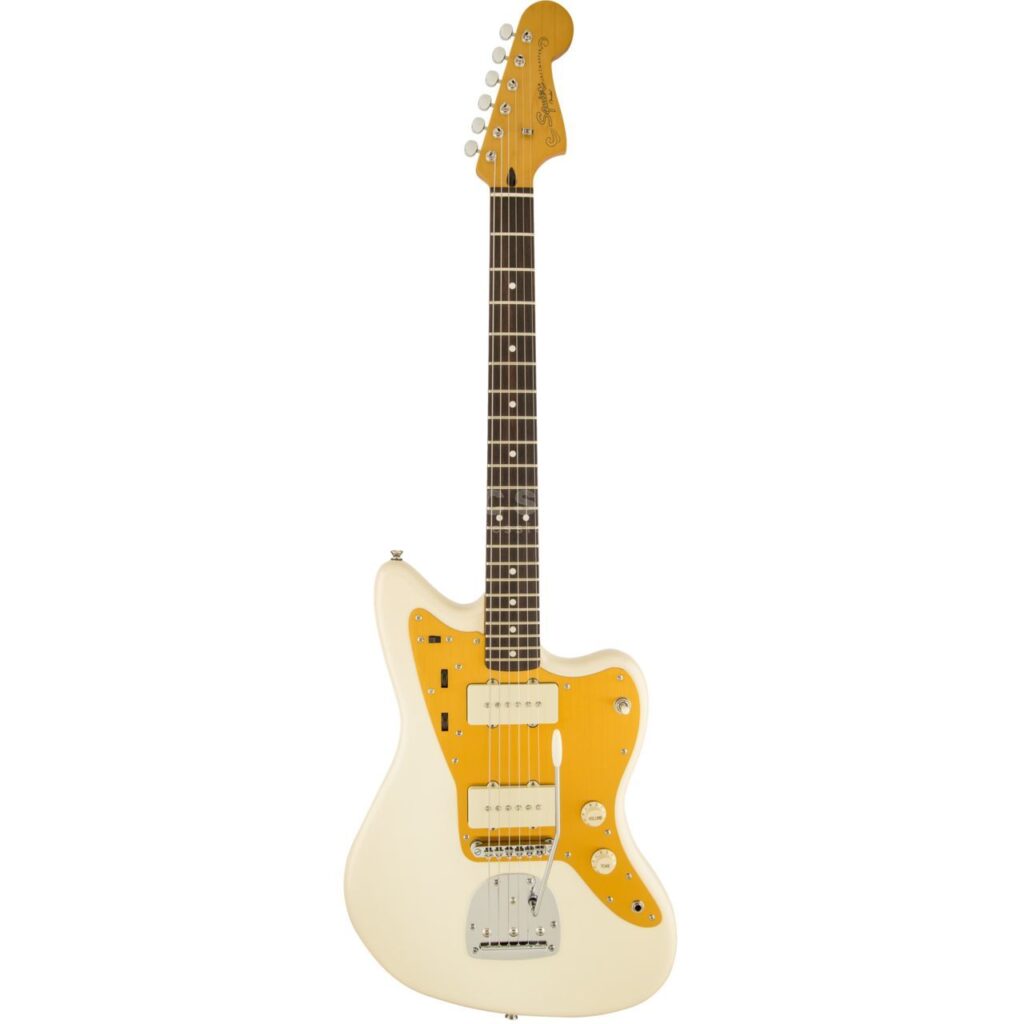
The Fender J Mascis Jazzmaster is offered with either a maple or rosewood fretboard in an array of colors. It comes standard with pickups designed by Mascis himself, offering two distinct tones. To top it off, there’s only one knob to be found on the entire instrument – which is used for volume control of both pickups at once in various combinations. The JM can be had for around $599 retail though you might find something cheaper if you’re patient enough to wait for a sale or coupon code. You can expect to pay more if you want it in a specific color other than black with white pickguard because that’s the most popular model. guitar I tested was brand new, straight from a store stock and didn’t have any blemishes on it whatsoever.
On the body of the guitar, you’ll find a pair of gold Jazzmaster pickups with white covers as well as a normal 3-way pickup selector switch. The JM doesn’t have an active/passive toggle, which is common on most Fender models nowadays. One oddity with these particular pickups is that they’re wired out-of-phase to each other by default, though I presume this was done for a specific reason since swapping them will result in an uncontrollable volume spike later on down the line. A regular volume knob as well as master tone knob round out the controls found on the guitar itself.
The bridge system is shared with other Fender models though in this case, it is a traditional 6-saddled bridge with individual saddles for each string. The JM doesn’t have any kind of tremolo system built into the bridge itself but that isn’t necessarily a problem since you could consider this an advantage in itself. Those who are used to locking tremolos might find playing with regular bridges very refreshing actually…you don’t have to tune quite as regularly and I personally think the tone benefits greatly from sticking to standard bridges. There’s also less to go wrong here compared to Floyd Rose or other floating systems.
The neck is what really sets this guitar apart from its peers however. It has a “C” profile shape, which places it somewhere between ’50s and ’60s neck dimensions. I’ve owned a few Jazzmasters in the past and this is by far the most comfortable one to play – particularly if you’re used to standard Fender Stratocaster shapes. The frets are smaller than usual too, making it very easy to pull off complicated licks and runs with minimal effort. You might expect that with such small frets that there would be some buzzing or dead notes every now and then but I didn’t experience anything of the sort while testing it out on my rig.
The guitar itself is fairly light considering it’s a full-sized instrument made from wood all around…though I do suspect the body materials have something to do with this reduced weight so don’t expect an axe made out of balsa wood to be this light. Compared to my Squier Vintage Modified Strat, the JM feels like a featherweight by comparison and it’s definitely easier on your shoulders for longer jam sessions or gigs.
The feel is very solid overall, with no creaking or other noises while wiggling it around in hand. The neck joint is certainly sturdy enough though I expected more resistance there considering that the body isn’t made from basswood like many other Fenders nowadays – but perhaps that extra bit of glue and thicker piece of maple makes up for the slightly less heavy composition of the guitar itself. As far as build quality goes, I can’t complain one iota about this guitar at all and you’d have an extremely hard time finding anything to pick at, even if you tried hard. I have seen guitars with a sloppier finish job but that’s not the case here thankfully – everything lines up just right and all of the joints are flush.



